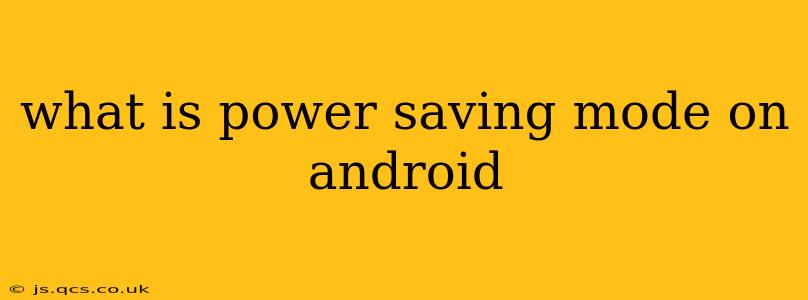Power saving mode on Android is a built-in feature designed to extend your phone's battery life by limiting certain functionalities and processes. When activated, it conserves energy by making several adjustments to your device's settings, helping you get more hours of use before needing to recharge. This is particularly useful when you're away from a power source or facing low battery levels. But how does it work, and what exactly does it change? Let's delve into the details.
How Does Android Power Saving Mode Work?
Android's power saving mode operates by strategically reducing resource consumption in several ways. The specific actions vary slightly depending on the Android version and phone manufacturer, but the general principles remain consistent. Here's a breakdown of common adjustments:
-
Reduced Background Activity: Many apps continue running in the background, consuming battery even when not actively used. Power saving mode limits this background activity, preventing apps from updating, syncing data frequently, or performing other tasks that drain power.
-
Lower Screen Brightness and Timeout: Your screen is one of the biggest battery consumers. Power saving mode typically lowers the maximum screen brightness and reduces the screen timeout, meaning the screen turns off quicker when inactive.
-
Limited Location Services: GPS and other location services require significant energy. Power saving mode often restricts location access to only essential apps or limits the accuracy of location tracking.
-
Reduced Performance: Some devices may throttle the processor's speed in power saving mode, resulting in slightly slower performance. This reduces the energy required to run the processor.
-
Disabled or Limited Vibrations and Haptics: Vibrations and haptic feedback consume a small amount of power. Power saving mode may reduce or disable these features.
-
Data Restrictions (Sometimes): In some cases, power saving mode might restrict background data usage, preventing apps from automatically downloading updates or syncing data unless explicitly requested.
What are the Different Power Saving Modes?
Many Android devices offer multiple levels of power saving, allowing you to choose the level of restriction that suits your needs. You might find options such as:
-
Ultra Power Saving Mode (or similar): This is the most aggressive mode, severely limiting functionality to maximize battery life. Expect significant restrictions on app usage, network activity, and other features. It's typically reserved for emergency situations.
-
Medium Power Saving Mode (or similar): This offers a balance between battery life extension and functionality. It makes moderate adjustments to various settings without significantly impacting the user experience.
-
Battery Saver (or similar): Some manufacturers might use this terminology to indicate a lighter power saving mode, focusing primarily on reducing screen brightness and background activity.
How to Turn On and Off Power Saving Mode?
The exact steps to activate and deactivate power saving mode differ slightly depending on the Android version and phone manufacturer. Generally, you can find the power saving option in your device's settings menu. Look for options like:
- Battery: This section often houses power saving settings.
- Power Management: Some manufacturers use this terminology.
- Device Care: This is another common location for battery optimization options.
Typically, you'll find a toggle switch or a menu to select different power saving levels.
Does Power Saving Mode Affect Performance?
Yes, power saving mode can impact performance, particularly in the more aggressive modes. You might experience slower app loading times, reduced responsiveness, and limitations on certain features. The performance decrease is a trade-off for increased battery life. The extent of this impact depends on the chosen power saving level and the phone's hardware capabilities.
Does Power Saving Mode Affect Data Usage?
Generally, power saving mode doesn't directly impact your data usage but might indirectly affect it. By restricting background data, it prevents apps from automatically syncing data or downloading updates, thus potentially reducing your total data consumption. However, it doesn't actively limit your data allowance.
When Should I Use Power Saving Mode?
Use power saving mode when you need to extend your phone's battery life, such as:
- When you're away from a power source for an extended period.
- When your battery level is critically low.
- When you're conserving battery to ensure your phone remains operational for essential tasks.
Remember to turn it off when you no longer need it to enjoy the full functionality of your device.
